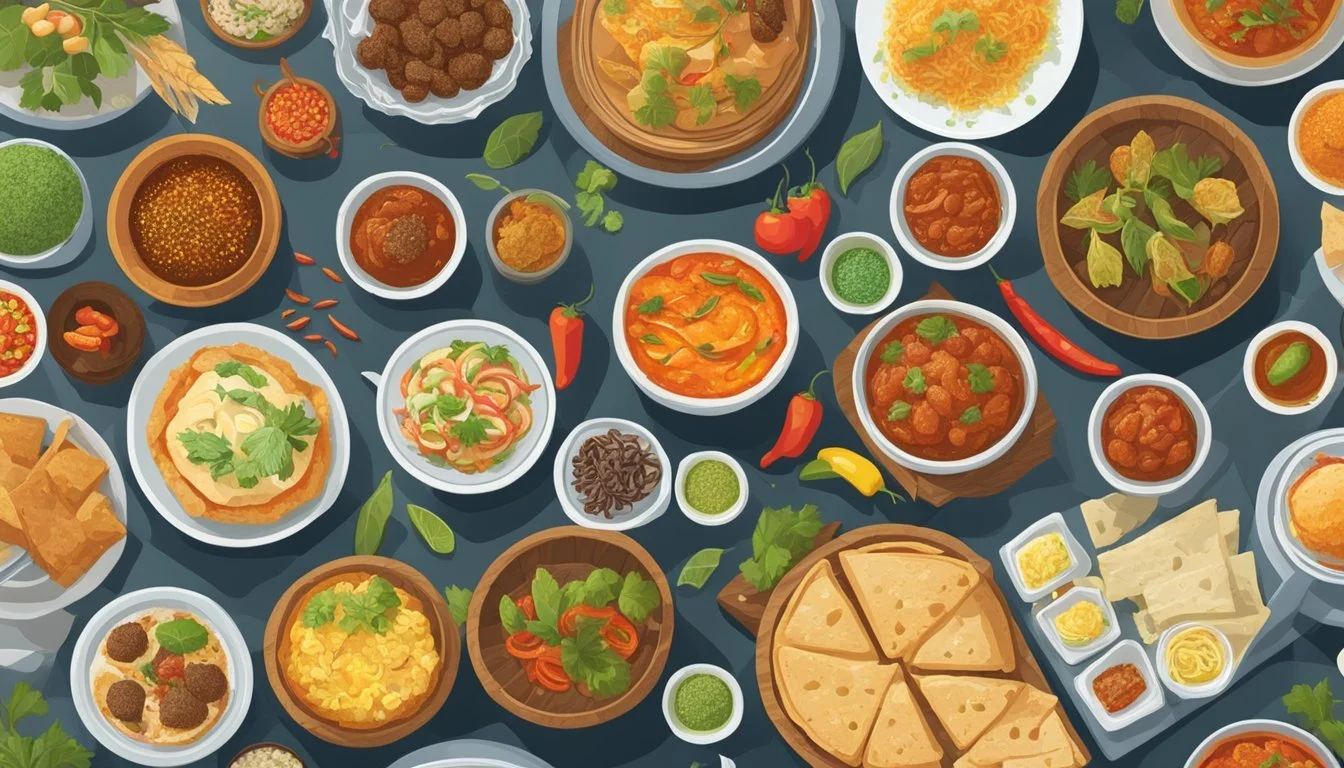Swicy Regional Specialties
A Tour of Global Sweet-Spicy Flavors
The culinary landscape is perpetually evolving, with dynamic trends that tantalize taste buds and invigorate markets. One such trend is 'Swicy'—a delightful blend of sweet and spicy flavors—that has captured the attention of consumers and the food industry alike. 'Swicy' derives from combining the sweetness that can mollify the robust zing of spice, creating a flavor profile that is both harmoniously balanced and strikingly vibrant. This burgeoning trend caters to a growing consumer desire for complex, multi-dimensional tastes that deliver a sensory thrill.
As 'Swicy' dishes gain popularity, the food industry is keen to capitalize on this trend, with restaurants and manufacturers incorporating this flavor fusion into their offerings. These sweet-spicy concoctions are not just delicious but are underpinned by a physiological reaction; the spice in swicy foods triggers the release of endorphins, heightening the pleasure of the dining experience. This reaction ensures that consumers come back for more, seeking out the endorphin rush along with the unique flavor that swicy dishes provide.
With the increased interest in swicy flavors, regional specialties that boast this sweet-spicy balance are finding their way into the global gastronomy scene. Local variations of swicy cuisine allow for the exploration of cultural diversity while satisfying the market's craving for new and exciting tastes. From the glaze of hot honey to the complexity of combined chilli and chocolate, swicy dishes offer a range of culinary adventures that appeal to a broad audience looking for the next level in flavor innovation.
The Rise of Swicy Flavors
In recent years, the blend of sweet and spicy tastes, known as "swicy," has become a notable food trend. This unique flavor combination is gaining traction across various culinary platforms, indicating a shift in consumer preferences towards more adventurous taste profiles.
Defining Swicy: The Portmanteau of Sweet and Spicy
The term "swicy" is a portmanteau that fuses the words "sweet" and "spicy" into a single descriptor. This merger represents not just a linguistic blend, but a culinary one as well. It captures the essence of combining sugary sweetness with fiery spice to create a balanced, appealing taste sensation. Such culinary pairings can be found across different cuisines, emphasizing their widespread appeal.
Market Research on Swicy Popularity
Statistics gathered by the market research firm Datassential reveal a 38% increase in sweet and spicy pairings on menus over the last year. This significant uptick underscores swicy's burgeoning status as a leading flavor trend. Products like hot honey are projected to continue their ascent, reflecting the blend's potential for longevity in the market.
Influence of Social Media and Food Trends
Social media platforms, particularly TikTok, have greatly influenced the proliferation of swicy as a fun and interesting food trend. The visual and viral nature of TikTok means that swicy dishes quickly gain attention and interest from viewers, leading to widespread popularity. Users share their swicy recipes and finds, encouraging others to join this flavorful bandwagon, thereby cementing swicy's role in the evolution of contemporary taste preferences.
Cultural and Historical Context
The interplay of sweet and spicy flavors is deeply rooted in many global cuisines, reflecting both tradition and innovation. This section delves into the historical combinations found in various cultures and looks at how modern gastronomy has embraced and adapted these 'swicy' profiles into contemporary dining experiences.
Historical Sweet-Spicy Combinations in Global Cuisines
In Korean cuisine, the juxtaposition of gochujang (a spicy chili paste) with sweeter elements has been a staple, featuring in dishes like tteokbokki, where rice cakes are paired with a sweet-spicy sauce. Szechuan cuisine is known for its bold flavors, often combining sichuan peppercorns with sweet undertones in dishes like Kung Pao Chicken.
Mexican hot chocolate is a quintessential example, marrying the heat of cinnamon or chili with the richness of sweet chocolate, demonstrating the harmony of sweet-spicy nuances since the Aztec and Mayan eras.
Adaptation of Swicy in Modern Gastronomy
Chefs around the world have taken these historical flavor pairings to new heights. Restaurants have seen a surge in swicy offerings, incorporating such flavors to create a complex palate experience. They use ingredients like hot honey or spicy jalapeño syrups in innovative desserts, adding a contemporary twist to the longstanding culinary tradition.
With an emphasis on balance and contrast, modern chefs often experiment with these flavor profiles, pushing the boundaries to offer diners both the comforting familiarity of sweet and the exciting kick of spice.
Ingredients and Flavor Profiles
Crafting a 'swicy' dish demands a careful melding of sweetness and spiciness, ensuring that each ingredient's impact is neither overshadowed nor overpowering.
Key Ingredients in Creating Swicy Dishes
To create the signature swicy flavor profile, chefs often harness the power of honey and chili peppers. Hot honey, a dynamic infusion of honey with chili peppers, has become a cornerstone ingredient in swicy cuisine. This potent combination utilizes the natural sweetness of honey complemented by the warm heat of chili peppers, which contain capsaicin—the compound responsible for spiciness.
Chocolate, especially dark varieties rich in cocoa, enters these blends to add depth and a touch of sweetness. Meanwhile, cinnamon can provide a warm, aromatic sweetness that pairs well with spicy elements. Here is a list of common ingredients found in swicy dishes:
Sweet Elements:
Honey
Sugar
Chocolate
Cinnamon
Spicy Elements:
Chili Peppers (Jalapeños, Habaneros, etc.)
Capsaicin-based hot sauces
Cayenne Pepper
Gochujang (Korean chili paste)
This diversity of ingredients allows for a multitude of combinations, each bringing its unique level of sweetness and spiciness to the table.
Understanding Flavor Balance and Complexity
The art of a swicy dish lies in achieving a balance where sweetness and spiciness enhance each other rather than compete. It's a delicate act of modulation where sugar or honey can tame the heat without reducing it to a mere afterthought. Conversely, the incorporation of peppers or capsaicin-based spices should add an invigorating kick without overwhelming the palate.
In terms of complexity, a well-crafted swicy dish offers a layered experience. The initial sweetness may greet the taste buds, followed by a gradual build-up of heat, which then develops into a pleasant warmth. Ultimately, this complexity ensures a memorable dining adventure.
Swicy in the Culinary Scene
The swicy flavor is a burgeoning trend in the culinary world, embraced by chefs and restaurateurs looking to innovate and stand out. It directly impacts menu creation and recipe development, as foodservice establishments seek to satisfy consumer cravings for this sweet-spicy fusion.
How Chefs Innovate with Sweet-Spicy Flavors
Chefs are harnessing the versatility of swicy to create new culinary experiences. For instance, the traditional Korean condiment gochujang, known for its complex flavor profile that includes sweetness and heat, is being integrated into various recipes that cater to Western palates. Chefs at chains like Outback Steakhouse and even fast-food outlets such as Pizza Hut use ingredients like spicy honey or jalapeño-infused maple syrup to introduce 'swicy' touches across diverse menus. These innovations reflect a broader trend of culinary creativity grounded in sweet and spicy elements.
Examples:
Incorporating gochujang in marinades for grilled meats.
Introducing spicy pineapple toppings on pizzas at Pizza Hut.
Adding a swicy glaze to signature chicken dishes at Chick-fil-A.
The Role of Swicy in Menu Development
The implementation of swicy flavors extends beyond individual recipes; it shapes menu development strategies. Restaurants, from quick service to premium dining, are keen to feature 'swicy' options as they attract customers seeking novel taste experiences. Burger King has experimented by adding sweet-spicy sauces to its sandwiches, boosting its appeal to patrons open to unexpected flavor combinations. Menus often highlight these options with descriptors that emphasize the sweet-spicy dichotomy, allowing patrons to easily identify dishes with the enjoyed swicy profile.
Menu Incorporations:
Burger King's specialty burgers with swicy barbecue sauce.
Limited-time offers featuring swicy elements to gauge consumer response.
By embracing swicy, chefs and restaurants are not only appealing to adventurous diners but also setting new trends within the culinary scene that could redefine future taste preferences.
Regional Swicy Specialties
Swicy flavor profiles are not just a global phenomenon, but they also manifest uniquely across various local cuisines. Each region adds its own twist, creating signature swicy dishes that reflect their culinary heritage.
Exploring Local Variations of Sweet and Spicy
Across the world, local variations of sweet and spicy flavors are tailored to regional palates. In Mexico, mangonada is a quintessential example, a frozen treat combining the sweetness of mango with the spice of chili powder and Tajín—a popular condiment consisting of chili, salt, and lime. Often, chamoy sauce, another sweet-spicy condiment made from pickled fruit, amplifies the swicy experience.
East Asian cuisines contribute extensively to the swicy trend. Tteokbokki, a beloved South Korean dish, marries the heat from gochujang (red chili paste) with a subtle sweetness. In Vietnam, nuoc cham sauce adds life to dishes with its delicate balance of spicy chili and sweet elements.
Signature Swicy Dishes from Different Cuisines
South Korea: Tteokbokki stands out with its spicy gochujang base and often includes sugar or syrup for a swicy profile.
Mexico: Mangonada boasts a blend of mango with Tajín and chamoy, offering a refreshing swicy kick.
Vietnam: Nuoc cham is essential in many dishes, contributing a sweet and spicy flavor through its combination of fish sauce, sugar, and chili.
United States: Various stateside brands, like Torani, offer sweet-spicy syrups for beverages and cocktails.
Jamaica: The Jamaican jerk seasoning incorporates scotch bonnet peppers with sweet spices such as allspice and cinnamon.
Thailand: Sriracha, a Thai-born hot sauce, is recognized worldwide for adding a swicy touch to not only traditional Thai dishes but also international cuisines.
Each region brings something unique to the table, reflecting the diversity and innovation within the swicy food trend.
Swicy in Commercial Products
Swicy flavors have deeply permeated the commercial food and beverage industries, offering a versatile range of products that cater to consumers seeking a balance of sweetness with a spicy kick. The trend manifests distinctly in snack foods and condiments, as well as innovative beverage offerings.
Prevalence in Snack Foods and Condiments
The appearance of swicy notes in snack foods has seen considerable growth, with big names like Doritos and Takis introducing products that feature a sweet yet spicy profile. Shelves in grocery stores are increasingly stocked with options blending heat from chili peppers with sugary coatings, catering to evolving consumer palates. For instance, Lay's Sweet & Spicy Honey flavored chips meld the mild heat of spice with the comforting sweetness of honey, embracing the swicy trend.
In the realm of condiments, hot sauce brands have innovated their products by adding elements like mango or pineapple to balance the heat, which can be used with a spork or poured, allowing for a range of uses from cooking to topping. This fusion creates an enticing complexity that enhances a variety of dishes.
Beverage Innovations: From Cocktails to Soft Drinks
Beverage producers are not far behind, with cocktails like the jalapeño margarita standing as a testament to the swicy revolution. The combination of spicy jalapeño with the smooth sweetness of the margarita base delivers a refreshing yet bold experience.
On the non-alcoholic front, soft drinks are being infused with swicy elements, offering intriguing alternatives to traditional flavors. These products often feature a subtle heat finish that complements the initial sweet taste, demonstrating the versatility of the swicy trend beyond the expected markets.
Consumer Engagement and Response
The sway of 'swicy' flavors has notably resonated with the modern palate, driving substantial consumer engagement, particularly among younger demographics. This section examines how Millennials and Gen Z have embraced these flavors and the feedback that has emerged from their experiences with swicy products and dishes.
Audience Reception: Millennials and Gen Z
Millennials and Gen Z are at the forefront of the swicy trend, fully embracing the fusion of sweet and spicy flavors. The zealous response from these groups is credited to their penchant for innovative culinary experiences and desire for intense, multi-dimensional tastes. Xocolatl, an ancient concoction, has seen a revival in swicy adaptations, signaling the groups’ respect for both heritage and novelty. The two demographics are not only consumers but also foodies and influencers who actively participate in swicy-related discussions and share their culinary adventures on social media platforms.
Millennials:
Often adventurous eaters
Seek out unique and authentic flavor combinations
Gen Z:
Highly influenced by social media trends
Value sustainability and global cuisine influence
Analyzing Feedback on Swicy Products and Dishes
Feedback on swicy products and dishes is gathered through various channels such as online reviews, social media comments, and direct consumer surveys. These sources provide invaluable insights into what is resonating with consumers and where there is room for improvement. A common thread in feedback is the appreciation for the balance of sweetness that tempers the heat, leading to an enjoyable sensory experience. However, it is also clear that transparency regarding spice levels is crucial to meet consumers' expectations and maintain satisfaction.
Consumer Feedback Highlights:
Positive reactions to the balance of flavors
Suggestions for clear labeling on spice levels
Requests for a broader range of swicy options in the marketplace
The engagement of Millennials and Gen Z with swicy flavors is an indicator of this trend's staying power and potential for growth in the culinary scene. Analyzing their feedback is essential for producers and restaurateurs to refine and develop products that meet these consumers' demands.
Health Considerations and Nutritional Impact
Swicy foods combine the complexity of sweet and spicy flavors, which can influence dietary choices and have various health benefits and risks.
Exploring the Health Benefits and Risks of Swicy Foods
Swicy foods often engage a dynamic combination of taste receptors, including those for sweetness and the heat sensation triggered by spicy components. Sweetness typically originates from sugar or natural sweeteners, providing immediate energy to the body. Spiciness, on the contrary, is measured by the Scoville scale and does not contribute caloric content. It is the capsaicin in spicy foods (What wine goes well with spicy food?) that can trigger endorphins, providing a natural pain relief and a sense of well-being.
Health Benefits
Endorphin release can lead to a positive mood boost.
Certain spicy components have been associated with anti-inflammatory properties.
Risks
High sugar content in sweet ingredients may contribute to caloric intake and affect blood glucose levels.
Overconsumption of spicy foods can lead to gastrointestinal discomfort for some individuals.
Sweet and Spicy as a Dietary Choice
When incorporating swicy flavors into one's diet, understanding the balance between sweetness and spiciness is crucial. For instance, Cowboy Candy, candied jalapeños, can be a palatable way to introduce moderate heat while controlling the sugar content. It is essential for consumers to consider the umami flavor, which can enhance satiety and reduce the need for added sugars or excessive spiciness. Making informed choices about the use of swicy foods offers a pathway to enjoy the sensory variety without compromising nutritional goals.
Dietary Considerations
Aim to balance the sweet with low-calorie or natural sweeteners.
Moderate the heat levels to avoid overwhelming the palate and digestive system.
Marketing Swicy: Strategies and Challenges
When approaching the unique market of swicy cuisine, businesses must employ innovative promotional techniques and adeptly navigate market challenges to appeal to consumer preferences.
Promotional Techniques for Swicy Cuisine
In the arena of culinary promotion, Monin stands as a beacon, having mastered the art of marketing swicy flavors to a broad audience. The company employs a multifaceted approach:
Physical Marketing Materials: A traditional method that still holds sway, using visually appealing menus and in-store displays to captivate potential customers.
Social Media Campaigns: Platforms like TikTok serve as fertile ground for viral marketing, where businesses share recipes and swicy-themed challenges to engage users and spread brand awareness.
The utilization of market research can steer a promotional campaign towards success. Companies that understand regional swicy delights are better equipped to craft messages that resonate with local populations. The New York Times has noted that successful marketers tailor their strategies to regional tastes, indicating the significance of cultural alignment in promotional efforts.
Addressing Market Challenges and Consumer Preferences
Businesses marketing swicy offerings face unique hurdles:
Balancing Flavor Profiles: Achieving the perfect harmony of sweetness and spice is critical. A dissonance can lead to a disconnect between offerings and consumer expectations.
Navigating Seasonal Trends: Capitalizing on 'sweet heat season' allows for timely marketing pushes which can generate increased consumer interest and sales.
Addressing these challenges involves a precise understanding of consumer preferences. Companies must remain agile, adapting to the evolving palate which often craves innovation within the swicy category. Regularly conducting market research provides actionable insights, enabling brands to refine their swicy offerings.
Surveys and Focus Groups: To tap directly into consumer desire, soliciting feedback on new swicy products.
Monitoring Consumer Data: Keeping a close eye on sales trends to adjust stock and marketing techniques accordingly.
By addressing these strategies and obstacles, companies can craft a cohesive approach to successfully market the complex and enticing flavors of swicy cuisine.
Future of Swicy
The swicy trend, marked by its offering of both heat and sweetness, has evolved from a fleeting fad into a mainstay in contemporary cuisine. Momentum in the food industry points toward a budding expansion in swicy offerings, backed by both innovation and burgeoning market potential.
Predicted Trends in the Swicy Market
Market research indicates a surge in demand for swicy flavors, with industry specialists like Andrea Ramirez spotlighting hot honey fried shrimp as emblematic of this broader trend. Analysts predict a 38% increase in swicy menu offerings, indicating a shift from niche to norm.
Key drivers for this growth in the swicy market include:
Consumer desire for novelty in flavor profiles, with a particular interest in artisanal and craft interpretations.
An increase in swicy pairings within fast casual dining spaces.
Expansion of international cuisine, merging traditional sweet and spicy elements into mainstream dining experiences.
Potential for Innovation and Growth in Swicy Cuisine
Constant evolution characterizes the food industry, and swicy cuisine stands at the forefront of this transformation. The versatility of sweet-spicy profiles paves the way for boundless culinary creativity.
Areas earmarked for innovation include:
The introduction of swicy elements in health-focused foods, countering the notion that healthy eating skimps on flavor.
Collaborations between swicy flavor creators and home cooking brands, making these combinations accessible to the DIY chef.
Cross-industry partnerships, leveraging the swicy trend in snack foods and beverages, expanding its impact beyond conventional dishes.
Critical to sustaining this upswing will be the industry's capacity to adapt to consumer feedback while continuing to push the boundaries of flavorful innovation.











